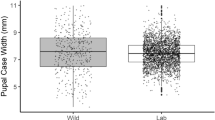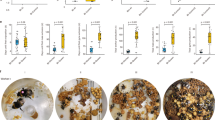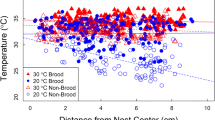Abstract
In bumble bees (Bombus spp.), where workers within the same colony exhibit up to a tenfold difference in mass, labor is divided by body size. Current adaptive explanations for this important life history feature are unsatisfactory. Within the colony, what is the function of the smaller workers? Here, we report on the differential robustness to starvation of small and large worker bumble bees (Bombus impatiens); when nectar is scarce, small workers remain alive significantly longer than larger workers. The presence of small workers, and size variation in general, might act as insurance against times of nectar shortage. These data may provide a novel, adaptive explanation, independent of division of labor, for size polymorphism within the worker caste.



Similar content being viewed by others
References
Alford D.V. 1975. Bumblebees, Davis-Poynter. London.
Beshers S.N. and Fewell J.H. 2001. Models of division of labor in social insects. Annu. Rev. Entomol. 46: 413–440
Bonabeau E., Dorigo M. and Theraulaz G. 2000. Inspiration for optimization from social insect behaviour. Nature 406: 39–42
Chapman R.E. and Bourke A.F.G. 2001. The influence of sociality on the conservation biology of social insects. Ecol. Lett. 4: 650–662
Chown S.L. and Gaston K.J. 1999. Exploring links between physiology and ecology at macro-scales: the role of respiratory metabolism in insects. Biol. Rev. 74: 87–120
Cnaani J. and Hefetz A. 1994. The effect of workers size frequency-distribution on colony development in Bombus terrestris. Insect. Soc. 41: 301–307
Cnaani J., Schmid-Hempel R. and Schmidt J.O. 2002. Colony development, larval development and worker reproduction in Bombus impatiens Cresson. Insect. Soc. 49: 164–170
Couvillon M.J. and Dornhaus A. 2009. Location, location, location: larvae position inside the nest is correlated with adult body size in worker bumble bees (Bombus impatiens). Proc. R. Soc. B 276: 2411–2418
Cumber R.A. 1949. The biology of humble-bees, with special reference to the production of the worker caste. Trans. R. Ent. Soc. Lond. 100: 1–45
Dornhaus A. 2008. Specialization does not predict individual efficiency in an ant. PLoS 6:e285
Foster R.L., Brunskill A., Verdirame D. and O’Donnell S. 2004. Reproductive physiology, dominance interactions, and division of labour among bumble bee workers. Physiol. Entomol. 29: 327–334
Free J.B. and Butler C.G. 1959. Bumblebees, Collins. London.
Gardner K., Foster R. and O’Donnell S. 2007. Experimental analysis of worker division of labor in bumblebee nest thermoregulation (Bombus huntii, Hymenoptera: Apidae). Behav. Ecol. Sociobiol. 61: 783–792
Gilchrist G.W., Huey R.B. and Serra L. 2001. Rapid evolution of wing size clines in Drosophila subobscura. Genetica 112: 273–286
Goulson D., Peat J., Stout J.C., Tucker J., Darvill B., Derwent L.C. and Hughes W.O.H. 2002. Can alloethism in workers of the bumblebee, Bombus terrestris, be explained in terms of foraging efficiency? Anim. Behav. 64: 123–130
Heinze J., Foitzik S., Fischer B., Wanke T. and Kipyatkov V.E. 2003. The significance of latitudinal variation in body size in a holarctic ant, Leptothorax acervorum. Ecography 26: 349–355
Hines H.M. 2008. Historical biogeography, divergence times, and diversification patterns of bumble bees (Hymenoptera: Apidae: Bombus). Syst. Biol. 57: 58–75
Hoffmann A.A. and Harshman L.G. 1999. Desiccation and starvation resistance in Drosophila: patterns of variation at the species, population and intrapopulation levels. Heredity 83: 637–643
Hölldobler B. and Wilson E.O. 1990. The Ants, Harvard University Press. Cambridge, Massachusetts. 732 pp
Jandt J. and Dornhaus A. 2009. Spatial organization and division of labor in the bumble bee, Bombus impatiens. Anim. Behav. 77: 641–651
Markiewicz D. and O’Donnell S. 2001. Social dominance, task performance and nutrition: implications for reproduction in eusocial wasps. J. Comp. Physiol. A 187: 327–333
Michener C.D. 2000. The Bees of the World, Johns Hopkins University Press. Baltimore.
O’Donnell S. and Foster R.L. 2001. Thresholds of response in nest thermoregulation by worker bumble bees, Bombus bifarius nearcticus (Hymenoptera: Apidae). Ethology 107: 387–399
Oster G.F. and Wilson E.O. 1978. Caste and Ecology in the Social Insects, Princeton University Press. Princeton, New Jersey. 352 pp
Peat J., Tucker J. and Goulson D. 2005. Does intraspecific size variation in bumblebees allow colonies to efficiently exploit different flowers? Ecol. Entomol. 30: 176–181
Plowright R.C. and Jay S.C. 1968. Caste differentiation in bumblebees (Bombus Latr.: Hym.) .1. Determination of female size. Insect. Soc. 15: 171–192
Porter S.D. and Jorgensen C.D. 1981. Foragers of the harvester ant, Pogonomyrmex owyheei: a disposable caste? Behav. Ecol. Sociobiol. 9: 247–256
Robinson G.E. 1992. Regulation of division-of-labor in insect societies. Annu. Rev. Entomol. 37: 637–665
Sokal R.R. and Rohlf F.J. 1995. Biometry, W.H. Freeman and Company. New York. 850 pp
Spaethe J. and Weidenmuller A. 2002. Size variation and foraging rate in bumblebees (Bombus terrestris). Insect. Soc. 49: 142–146
Stillwell R.A.C., Morse G.A.E. and Fox C.A. 2007. Geographic variation in body size and sexual size dimorphism of a seed-feeding beetle. Amer. Nat. 170: 358–369
Telonis-Scott M., Guthridge K.M. and Hoffmann A.A. 2006. A new set of laboratory-selected Drosophila melanogaster lines for the analysis of desiccation resistance: response to selection, physiology and correlated responses. J. Exp. Biol. 209: 1837–1847
Toth A.L. and Robinson G.E. 2005. Worker nutrition and division of labour in honeybees. Anim. Behav. 69: 427–435
Tschinkel W.R. 1998. Sociometry and sociogenesis of colonies of the harvester ant, Pogonomyrmex badius: worker characteristics in relation to colony size and season. Insect. Soc. 45: 385–410
Wilson E.O. 1985. The sociogenesis of insect colonies. Science 228: 1489–1495
Wilson E.O. 1987. Causes of ecological success: the case of the ants. J. Anim. Ecol. 56: 1–9
Yerushalmi S., Bodenhaimer S. and Bloch G. 2006. Developmentally determined attenuation in circadian rhythms links chronobiology to social organization in bees. J. Exp. Biol. 209: 1044–1051
Acknowledgments
We thank Jennifer Bonds for her help with data collection and Duncan Jackson and Dan Papaj for comments on the manuscript. This work was funded by a NIH PERT fellowship to MJC through the Center for Insect Science.
Author information
Authors and Affiliations
Corresponding author
Rights and permissions
About this article
Cite this article
Couvillon, M.J., Dornhaus, A. Small worker bumble bees (Bombus impatiens) are hardier against starvation than their larger sisters. Insect. Soc. 57, 193–197 (2010). https://doi.org/10.1007/s00040-010-0064-7
Received:
Revised:
Accepted:
Published:
Issue Date:
DOI: https://doi.org/10.1007/s00040-010-0064-7




